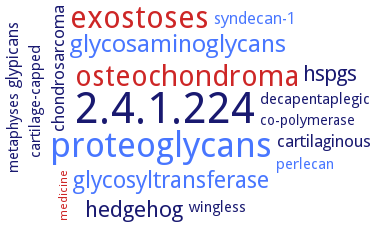Please wait a moment until all data is loaded. This message will disappear when all data is loaded.
Please wait a moment until the data is sorted. This message will disappear when the data is sorted.
Carcinoma
Exostosin1 as a novel prognostic and predictive biomarker for squamous cell lung carcinoma: A study based on bioinformatics analysis.
Diabetes Mellitus
Lack of replication of common EXT2 gene variants with susceptibility to type 2 diabetes in Lebanese Arabs.
Diabetes Mellitus, Type 2
Lack of replication of common EXT2 gene variants with susceptibility to type 2 diabetes in Lebanese Arabs.
Exostoses
Heparan sulfate deficiency leads to hypertrophic chondrocytes by increasing bone morphogenetic protein signaling.
Exostoses
Old gene, new phenotype: mutations in heparan sulfate synthesis enzyme, EXT2 leads to seizure and developmental disorder, no exostoses.
Exostoses
Structural analysis of glycosaminoglycans in animals bearing mutations in sugarless, sulfateless, and tout-velu. Drosophila homologues of vertebrate genes encoding glycosaminoglycan biosynthetic enzymes.
Exostoses, Multiple Hereditary
Case Report of the positive exostosin-1 without B-cell lymphoma-2 gene expression of giant cell tumor lesion in hereditary multiple exostosis.
Exostoses, Multiple Hereditary
Correlation between mutated genes and forearm deformity in patients with multiple osteochondroma.
Exostoses, Multiple Hereditary
Deletion of exon 8 from the EXT1 gene causes multiple osteochondromas (MO) in a family with three affected members.
Exostoses, Multiple Hereditary
Etiological point mutations in the hereditary multiple exostoses gene EXT1: a functional analysis of heparan sulfate polymerase activity.
Exostoses, Multiple Hereditary
Familial nephropathy and multiple exostoses with exostosin-1 (EXT1) gene mutation.
Exostoses, Multiple Hereditary
Heparan sulfate deficiency leads to hypertrophic chondrocytes by increasing bone morphogenetic protein signaling.
Exostoses, Multiple Hereditary
Identification and functional characterization of the human EXT1 promoter region.
Exostoses, Multiple Hereditary
Intraosseous atypical chondroid tumor or chondrosarcoma grade 1 in patients with multiple osteochondromas.
Exostoses, Multiple Hereditary
Large-scale mutational analysis in the EXT1 and EXT2 genes for Japanese patients with multiple osteochondromas.
Exostoses, Multiple Hereditary
Multiple osteochondromas: clinicopathological and genetic spectrum and suggestions for clinical management.
Exostoses, Multiple Hereditary
Novel and recurrent mutations in the EXT1 and EXT2 genes in Chinese kindreds with multiple osteochondromas.
Exostoses, Multiple Hereditary
Novel exostosin-2 mutation identified in a Chinese family with hereditary multiple osteochondroma.
Exostoses, Multiple Hereditary
Somatic loss of an EXT2 gene mutation during malignant progression in a patient with hereditary multiple osteochondromas.
Exostoses, Multiple Hereditary
Targeted Next-Generation Sequencing Newly Identifies Mutations in Exostosin-1 and Exostosin-2 Genes of Patients with Multiple Osteochondromas.
Giant Cell Tumors
Case Report of the positive exostosin-1 without B-cell lymphoma-2 gene expression of giant cell tumor lesion in hereditary multiple exostosis.
Infections
Enterovirus 71 uses cell surface heparan sulfate glycosaminoglycan as an attachment receptor.
Intellectual Disability
Novel exostosin-2 missense variants in a family with autosomal recessive exostosin-2-related syndrome: further evidences on the phenotype.
Neoplasms
Case Report of the positive exostosin-1 without B-cell lymphoma-2 gene expression of giant cell tumor lesion in hereditary multiple exostosis.
Neoplasms
Deletion of exon 8 from the EXT1 gene causes multiple osteochondromas (MO) in a family with three affected members.
Neoplasms
Epigenetic loss of the familial tumor-suppressor gene exostosin-1 (EXT1) disrupts heparan sulfate synthesis in cancer cells.
Neoplasms
Increased EXT1 gene copy number correlates with increased mRNA level predicts short disease-free survival in hepatocellular carcinoma without vascular invasion.
Neoplasms
Multiple osteochondromas: clinicopathological and genetic spectrum and suggestions for clinical management.
Neoplasms
Structural analysis of glycosaminoglycans in Drosophila and Caenorhabditis elegans and demonstration that tout-velu, a Drosophila gene related to EXT tumor suppressors, affects heparan sulfate in vivo.
Neoplasms
Tout-velu is a Drosophila homologue of the putative tumour suppressor EXT-1 and is needed for Hh diffusion.
Seizures
Novel exostosin-2 missense variants in a family with autosomal recessive exostosin-2-related syndrome: further evidences on the phenotype.
Seizures
Old gene, new phenotype: mutations in heparan sulfate synthesis enzyme, EXT2 leads to seizure and developmental disorder, no exostoses.




 results (
results ( results (
results ( top
top









